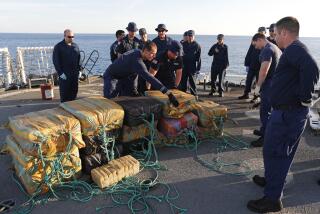Glut in U.S. Cocaine Market : Drug Traffickers Seen Targeting Spain
- Share via
MADRID — Hit by a glut in the U.S. cocaine market, Colombian drug runners are taking their billion-dollar business to Europe, and Spain is providing a ready-made Latin connection.
Cocaine seizures in Europe nearly doubled last year to an estimated 2.6 tons--and more than 40% of the captures were made in Spain.
“If I was a trafficker, I’d come here too,” said David Herrera, who heads the U.S. Drug Enforcement Administration operations in Madrid. “The prices are high and the seizures and arrests are low compared with the United States.”
Cocaine still has a certain allure in Europe as a “safe” drug. In Spain, until narcotics legislation was stiffened in March, it was not listed as a dangerous or addictive drug.
Street prices across Europe reach the boom rate of $45,000 to $50,000 per kilogram, about four times higher than on the American market, Herrera said.
In Europe’s biggest cocaine seizure to date, Spanish agents arrested a ring of Colombian and Ecuadoran traffickers in Madrid on March 25 and found 325 kilograms of cocaine hidden in a shipment of building panels from Ecuador.
State police chief Jose Maria Rodriguez called the capture a “major blow” to traffickers’ attempts to open European outlets with Spain as the gateway.
But so far, the bulk of Europe-bound smuggling is done by small-time couriers, mostly from Colombia and Peru, who receive $1,500 to $5,000 to bring in small quantities.
“They’ve turned the airlines into drug shuttles,” said Fernando Ramos, who heads the Civil Guard’s 23-member anti-drug unit at Madrid’s international airport. “They may carry less than 3 kilos but they come in swarms. And by the end of the month, that adds up.”
Fifty-six direct weekly flights link Madrid to cities such as Bogota, Caracas and Lima. And, because of historic ties, entry visas are not required for the more than half a million Latin Americans who visit Spain each year.
“The Spanish angle was a natural,” Herrera said. “You’re talking social customs, language and a large Latin American community they can slip into like a shoe.”
Fifty-five percent of the total 1.1 tons of cocaine seized in Spain last year was captured at the Madrid airport, hidden in containers ranging from hollowed-out statuettes of the Virgin Mary to guitars.
“These are small fry,” Ramos said. “They know very little about the big dealers. Most of them are afraid to talk because they say their bosses keep tabs on their families back home.”
Spain’s beleaguered anti-drug forces received a welcome boost recently when harsher narcotics laws were introduced, doubling prison terms for hard-drug traffickers to 23 years and allowing the confiscation of property belonging to suspects.
“My agents were tailing Jaguars in run-down cars,” Col. Asenio Ayuso, chief of the Civil Guard customs brigade, said. “This new law will give us access to rapid vehicles and rapid launches. We’re going to need all the help we can get.”
Spain’s main fear is that Colombian cocaine kingpins have larger designs on the country both for money laundering and as the entry point for more sophisticated trafficking.
There are suspicions that Jorge Luis Ochoa, a leader of the clan that works out of Medellin, Colombia, was setting up a network in Spain, when he was arrested in Madrid in November, 1984.
“Ochoa was not here on a vacation, we’re certain of that,” said a Spanish anti-drug official.
Ochoa spent 20 months in jail pending an extradition request by the United States but was, surprisingly, returned to Colombia to face cattle-rustling charges.
So far, Spanish anti-drug agents have been largely immune to bribery.
More to Read
Sign up for Essential California
The most important California stories and recommendations in your inbox every morning.
You may occasionally receive promotional content from the Los Angeles Times.












